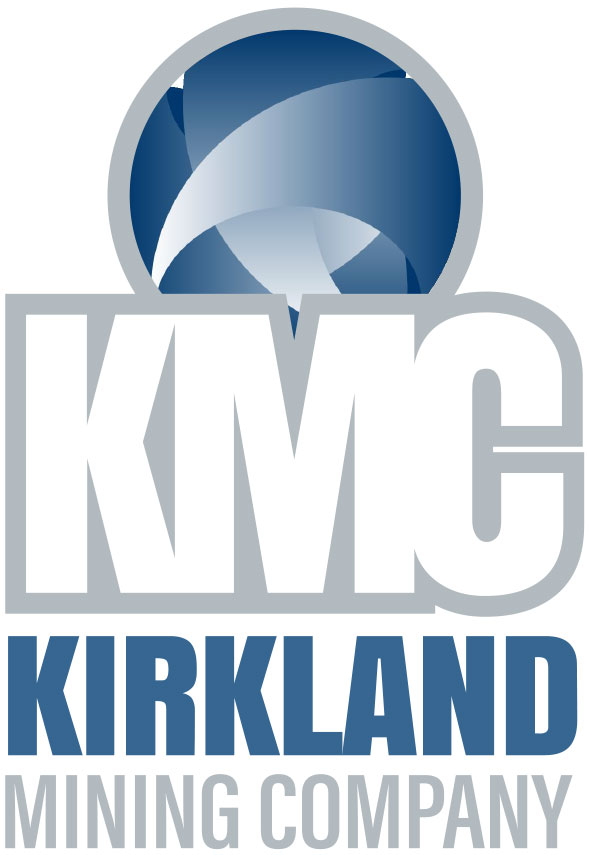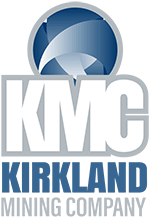
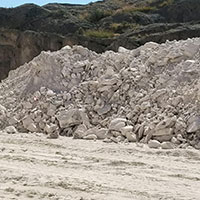
The Mining and Operations Processes
WHILE THE KMC PROJECT has identified more than 39 millon of tons of HQP reserves, a combination of market, logistical, and community factors has led to the estimated maximum production of 500,000 tons per year identified in the BLM permitting process. These volumes, and the expected final processing off-site, mean that the KMC project will look much smaller and simpler than the typical large, hard-rock mines many people in Arizona are familiar with. To better understand the expected development and operation of the mine, we have summarized all expected operating activities.
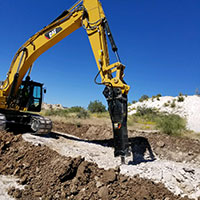
MINING NATURAL POZZOLANDUE TO THE RELATIVELY SOFT and uniform nature of the native material, it is not anticipated that drilling and blasting will be needed in any phase of the recovery of raw pozzolan. Instead, the site will operate more like an aggregate (construction sand, gravel or rock) quarry where raw materials are recovered in smaller layers or sections by bulldozer, excavator, scraper and/or front end loader. As recovered, raw material will be stockpiled to later be fed into a crusher for processing. The decisions on where and how to mine will be guided by the Mining and Reclamation Plan of Operation, which has been developed by KMC and must be approved by BLM as part of its permitting process.
PROCESSINGBECAUSE THE RAW POZZOLAN will be taken off-site to undergo the final grinding process, the only processing to be performed at the KMC site will be the crushing of mined material to a consistent size of less than 2 inches. [READ MORE]
Equipment for this process will be selected based on the natural size of coarse raw material that is generated in the mining process and also based on optimum setup for energy consumption, production rate, dust and noise control, and size gradation of the output product. All equipment under consideration (impact, jaw and cone crushers) is of the type commonly used by aggregate producers throughout Arizona and the US and is readily sourced and serviced by local Arizona vendors. Additionally, because this equipment has more production capacity than is needed to meet projected demand, total crusher operating time is estimated to be no more than 1,400 hours per year for maximum production and likely 300 to 500 annual hours in the early years of operation. This lends itself to the use of portable crushers that can move in and around the site periodically to build stockpiles for ongoing shipments while isolating actual running time to just a handful of months throughout the year and to the most amenable times of the day and week.
SAFETYOVERALL, THE MINING INDUSTRY is one of the most heavily regulated in the world. Since the 1970s, the federal government has overseen safety at all active mine sites through the Mine Safety and Health Administration (MSHA). As a mine site, KMC’s project will be subject to the extensive MSHA regulations as well as at least 2 random, unannounced inspections each year. [READ MORE]
In addition, the office of the Arizona State Mine Inspector (ASMI) carries concurrent jurisdiction over the project site. More importantly, the operators of the project have decades of experience managing safe mining and crushing operations and have a demonstrated commitment to creating and maintaining a world class culture of safety and social responsibility. The safety and health of our team members, vendors and neighbors will take priority every time over production and profit goals. To ensure this in practice, KMC will have its own safety program with standards sometimes more stringent than those of MSHA and/or ASMI. The operation will have a dedicated safety officer ensuring compliance with internal and external requirements and a safety team made up of both leadership and field level team members to monitor and recommend best practices in safety and health.
WEIGHING AND HAULINGAS MATERIAL IS STOCKPILED from the crushing process, a front end loader will place material into dump trucks which will then travel to a scale to capture the weight of pozzolan loaded, the overall gross vehicle weight (80,000 pound legal maximum), and print a certified weigh ticket (bill of lading) displaying these weights and the shipment destination. [READ MORE]
Scales and weighmasters will be certified under the guidelines of the Arizona Department of Weights and Measures (or its successor agency), with scales calibrated and certified by independent third parties at least twice per year. A copy of each weigh ticket will be kept at the KMC site.
Prior to leaving the site, each truck will pull to a designated area to safely install a tarp to prevent pozzolan material from exiting the truck bed during transport; ALL TRUCKS HAULING POZZOLAN WILL BE REQUIRED TO BE ADEQUATELY TARPED BEFORE LEAVING THE SITE. It is anticipated that pozzolan transportation will be contracted to one or more independent parties. As shipment volume and local driver availability warrants, KMC plans for its trucking partner to park trucks at its site to ensure truck availability and reduce the time and expense of lengthier empty trips (“deadheading”) to the site. This will ultimately lead to many additional job opportunities for qualified truck drivers within the communities surrounding the site.
Truck traffic from the KMC site is understandably a key concern of many local residents. In particular, many questions have been in regard to how many trucks will be added to the roads and which routes they will take. At this time, it is clear that all material will leave the site via truck. A current shipping forecast and corresponding Traffic Impact Analysis are currently being developed to identify possible routes and volumes from the site, including several potential rail transloading (transferring from truck to rail) sites in the area. These studies utilize independent traffic engineers and may take several months to complete in full detail.
Because the permitting process asks that KMC build its analysis around its expected maximum shipping volume, 500,000 tons per year has been published as the site’s shipping potential. While shipments are anticipated to be significantly less in the early years, changing market conditions could drive these volumes closer to that maximum sooner than expected. Thus, the entire permitting process is designed around the potential to produce to the mine’s estimated maximum output.
It is estimated that 25 tons of pozzolan can be hauled in each truckload, yielding an estimated total of 80 loaded trucks leaving, and 80 empty trucks entering, the site each day (on a 5-day week) at the 500,000 ton annual volume. Truck counts are directly proportional to shipping volumes, so a 100,000 ton annual forecast, for example, would yield approximately 16 truckloads leaving the site daily, Monday through Friday. As stockpiling and storage buffers at the site and destination allow, KMC retains a reasonable amount of flexibility in adjusting its hauling schedules during the typical day and week to achieve its needs with the least impact to our neighbors and the motoring public.
Many residents have also asked about the destination of the pozzolan material. We understand this affects the anticipated truck routes and also, presumably, the broader sense that KMC is a reputable company with a viable business plan. It is important to note, however, that because pozzolans are not typical commodities like copper and gold which are traded on global public markets, key partnerships and competitive plans are very sensitive information to the company and its potential competitors. Keeping this important fact in mind, KMC is committed to sharing as much information as possible to help evaluate impacts and potential mitigation as more information is developed regarding the traffic study and planned truck routes.
NOISE, VIEW, AND DUST ABATEMENTTHESE POTENTIAL IMPACTS from the project to the people and environment surrounding it will be carefully considered. Importantly, a particular impact such as noise or view, can be felt very differently by each individual based on their unique personal and geographic perspective. For this reason, it is vital to receive feedback from the public to help us consider various perspectives. BLM will take these concerns into consideration and evaluate the effects, and appropriate mitigation measures will be implemented. KMC’s forward-thinking design and operational measures will be continually employed in conjunction with informal and ongoing dialogue with our neighbors as the project kicks-off and progresses. [READ MORE]
For example, KMC is evaluating options using natural terrain, constructed barriers and/or set backs as options to minimize noise and viewshed effects. Additionally, the company will explore all options for optimizing hours of operation to meet its production needs while minimizing local impact.
Concerns over dust have been expressed by local residents. Both KMC and its regulators will be taking substantial steps to minimize fugitive dust created by operations and ensure the health and safety of our team members and neighbors. During operation, dust and air quality will be monitored at the site to ensure strict compliance with the air quality permit administered by the Arizona Department of Environmental Quality (ADEQ). This permit will have detailed requirements for mitigating, measuring and reporting air quality information. KMC is working proactively with ADEQ to evaluate equipment selection and various control measures for effectiveness in reducing dust and emissions. We will continue this effort with ADEQ and other agencies to ensure compliance with all our regulatory obligations.
Operationally, KMC will address dust control from both vehicle travel and crushing operations. For plant roads, dust can be mitigated through a variety of industry-standard practices like application of water (frequency to be dictated by permit conditions), dust suppressants and road cover. In the crushing process, all equipment considered by KMC includes state-of-the-art technology for dust control, including the use of covered transfer and processing points, and water spray bars as warranted. KMC will be testing different types of equipment over the next several months to evaluate the most effective means of crushing material.
We understand that water use is an important issue for the local community, and for all residents of the desert southwest. KMC is undertaking a detailed water study to confirm sufficient water supplies that will minimize the potential impact on the aquifer and surrounding wells. At our currently estimated maximum production level, water use at the site is expected to be approximately 35,000 gallons per day. Almost all of that water use will be dedicated to dust control. This use may be substantially less in the early years, although air permit conditions may dictate certain levels of watering regardless of shipment or production volume. Even at maximum production, this volume represents a very small fraction of the known water consumption in the local area. Nonetheless, KMC clearly recognizes the sensitivity of water use and the sometimes conflicting demands of dust control, and we are evaluating all of our options to minimize water consumption while still mitigating the potential for fugitive dust.
Another important issue related to dust has been the ongoing concern that the Kirkland HQP contains a hazardous form of silica, erionite, or some other form of asbestos-like material that may be dangerous if inhaled. To date, KMC has participated in five separate independent studies of multiple samples across the Kirkland site. None of these five studies have shown evidence of the existence of erionite or other asbestiform silica. Fine particulate matter (pm10) of any kind (dust, ash, smoke, etc.) can be harmful to anyone, and the generation of this is regulated under air quality permits as a “nuisance” source. Separate from this, the unique dangers of crystalline silica inhaled over time are well-documented, but the Kirkland pozzolan material is amorphous (NON-crystalline). In fact, it is the non-crystalline nature of any silica material that defines it as a potential pozzolan that will work in cementitious applications; the lack of crystalline silica in the native material is part of what confirms it as such a uniquely effective natural pozzolan source.
For ourselves and our team members spending significant time at the mine site, we share the public concern about all health hazards. In addition to air quality regulations, the Mine Safety and Health Administration (MSHA) rules and regulations will further govern the maintenance and monitoring of our team members’ health and safety at the site. Given the history of asbestos-related issues in this country, we completely understand high degree of sensitivity. It is for that reason that KMC has gone to great lengths to investigate the presence of erionite or other hazardous forms of silica in the Kirkland material. The bottom line is that, after many studies by many parties, none has been found.
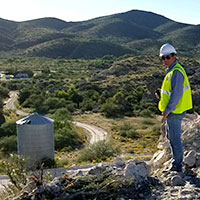
RECLAMATIONBECAUSE RESPONSIBLE MINING means considering impacts not only during operation but after mine closure, KMC has already begun planning for reclamation of the site. BLM standards, along with other unique site-specific requirements that may be instituted through the permitting process, will define the timing and type of reclamation to be completed by KMC in the Mining and Reclamation Plan of Operations (MRPO). [READ MORE]
Additionally, KMC will be required by BLM to provide ongoing evidence of financial assurance that adequate funds will be available to complete required reclamation if and when the mine closes.
Our mining will be directed with the end in mind. Modern safety factors such as sidewall sloping and appropriate revegetation are considered in the mine’s reclamation plan. Consideration of post-mining use will be front and center, reducing the burden on both the operator and the community. This approach provides a unique opportunity for local communities, regulators and political leaders to participate in a proactive dialogue about how the mine site could be most useful to all stakeholders after its primary use has ended.
For example, mining projects around the world are working with neighbors to create unique post-mine environments used for wildlife habitat, recreation, water storage, waste recovery, solar/PV arrays and other innovative developments. While the base reclamation requirements will be dictated by regulation, opportunities abound for developing higher value end-uses for the site. As a mine plan of operations is a “living document,” we hope our neighbors will think about constructive uses of this valuable site and actively engage us throughout operations to achieve our objectives while planning for the greatest benefit for future generations.




